To visit Tristan da Cunha is to visit another world - another life, another
time.
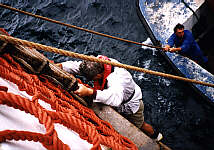 Situated
at 37 South and 12 West and 2000 kms from St Helena and 2800 kms from
the nearest mainland Cape of Good Hope in South Africa, Tristan rises
out of the ocean, it's volcanic peak crowned with an almost permanent
cap of white cloud. Situated in the South Atlantic, summer on Tristan
da Cunha falls between December to March. During the winter months the
central peak,rising to a height of 2010 metres, is covered in snow. Situated
at 37 South and 12 West and 2000 kms from St Helena and 2800 kms from
the nearest mainland Cape of Good Hope in South Africa, Tristan rises
out of the ocean, it's volcanic peak crowned with an almost permanent
cap of white cloud. Situated in the South Atlantic, summer on Tristan
da Cunha falls between December to March. During the winter months the
central peak,rising to a height of 2010 metres, is covered in snow.
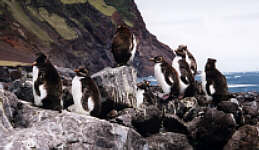 The island is roughly
circular in shape with an average diameter 10 kms and has a total area
of 78 sq kms but only 5 sq kms of flat area at the northwest part. Narrow
valleys or gulches radiate from the central peak. During the wet season
and close the famous "roaring forties" the steep valleys become
fast running torrents washing minerals down from the slopes, to the
regions below. On the northwestern plain, the deposits has formed green
fields where the islanders grow their potatoes. The island is roughly
circular in shape with an average diameter 10 kms and has a total area
of 78 sq kms but only 5 sq kms of flat area at the northwest part. Narrow
valleys or gulches radiate from the central peak. During the wet season
and close the famous "roaring forties" the steep valleys become
fast running torrents washing minerals down from the slopes, to the
regions below. On the northwestern plain, the deposits has formed green
fields where the islanders grow their potatoes.
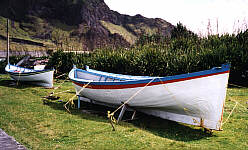 The
40 kms of coastline is exposed to the storm tossed seas, comprising
magnificient basalt cliffs, some is rising steeply to 600 meters. The
surrounding seas are rich in fish, providing Tristan da Cunha with one
of its main sources of revenue - crawfish. Caught and deep frozen, the
crawfish is shipped via South Africa to the United States and Japan,
where it is much appreciated as a delicacy. The
40 kms of coastline is exposed to the storm tossed seas, comprising
magnificient basalt cliffs, some is rising steeply to 600 meters. The
surrounding seas are rich in fish, providing Tristan da Cunha with one
of its main sources of revenue - crawfish. Caught and deep frozen, the
crawfish is shipped via South Africa to the United States and Japan,
where it is much appreciated as a delicacy.
The other main source of income of the island is the sale of postage stamps, which are
collected by numerous philatelists and collectors all over the world.
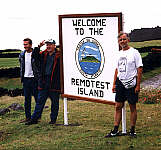 When
sailing from Brazil to Cape of Good Hope, the Portuguese navigator Tristao
da Cunha discovered the island. However he found it was impossible to
land as the sea was tempesteous. The first settler to arrive on the
island was an american - Captain Jonathan Lambert - who landed in 1811
and promptly declared to kane absolute possession of the island of Tristan
da Cunha. Unfortunately he drowned while fishing in 1812 together with
2 other men. When
sailing from Brazil to Cape of Good Hope, the Portuguese navigator Tristao
da Cunha discovered the island. However he found it was impossible to
land as the sea was tempesteous. The first settler to arrive on the
island was an american - Captain Jonathan Lambert - who landed in 1811
and promptly declared to kane absolute possession of the island of Tristan
da Cunha. Unfortunately he drowned while fishing in 1812 together with
2 other men.
In 1816, the british annexed the island and set up a garrison as a
precaution against the French who, it was thought, were planning to
recue Napoleon from exile on the island of St Helena. NEW>Tristan
500 years<NEW
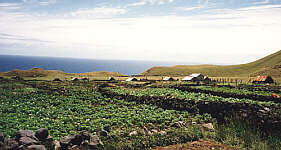 In
the end it was Corporal William Glass from Kelso in Scotland, who is
regarded as the Founder of the present community. Following a tour of
duty with the garrison, he returned with his wife and two children,
two companions, a coloured woman, they made up the total of six inhabitants
after the garrison had finally departed. In
the end it was Corporal William Glass from Kelso in Scotland, who is
regarded as the Founder of the present community. Following a tour of
duty with the garrison, he returned with his wife and two children,
two companions, a coloured woman, they made up the total of six inhabitants
after the garrison had finally departed.
The community was still no more than eleven flax thatched cottages
built from blocks of volcanic rock when, in 1867, HRH Prince Alfred,
Duke of Edinburgh and second son of Victoria, visited the island while
voyaging round the world and gave the settlement of Edinburgh its present
name.
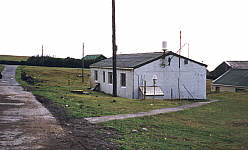 The
Settlement of Edinburgh now numbers just over 300 proud and hospitable
people with only seven surnames among them. Through the islanders veins
flows the blood of English sailors from Nelson's fleet, Americans, Italians,
Dutch and mulattos from St Helena and South Africa. English is the native
tongue, albeit a slightly strange, preserved Georgian dialect laced
with a few early Americanisms. The
Settlement of Edinburgh now numbers just over 300 proud and hospitable
people with only seven surnames among them. Through the islanders veins
flows the blood of English sailors from Nelson's fleet, Americans, Italians,
Dutch and mulattos from St Helena and South Africa. English is the native
tongue, albeit a slightly strange, preserved Georgian dialect laced
with a few early Americanisms.
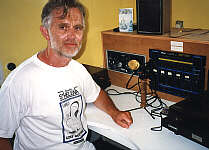 The
sea around Tristan da Cunha is blue, and, in the summer, the sun is
warm. The tableland above the cliffs is lush. Just above sea level the
north-west corner of the island there is enough flat land to accomodate
the Settlement. Southwestwards stretches space for grazing and the famous
potato patches. The
sea around Tristan da Cunha is blue, and, in the summer, the sun is
warm. The tableland above the cliffs is lush. Just above sea level the
north-west corner of the island there is enough flat land to accomodate
the Settlement. Southwestwards stretches space for grazing and the famous
potato patches.
Tristan da Cunha with its neighbouring islands, Inaccessible and Nightingale, is an
ornthologists dream with fourteen different types of petrel including the greater
shearwater, the prion and the storm petrel; the rockhopper penguins; the yellowed-nosed
albatross and the wandering albatross.
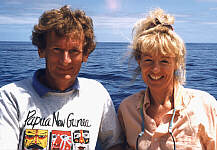 The
Settlement of Edinburgh has a distict air of yesteryear about it, although
it has all the moderna conveniences of mains water, electricity and
sanitation. There is a small but interesting museum, a craft shop, a
swimmingpool and a radio-station. There are old style local shops, and
a large supermarket. The
Settlement of Edinburgh has a distict air of yesteryear about it, although
it has all the moderna conveniences of mains water, electricity and
sanitation. There is a small but interesting museum, a craft shop, a
swimmingpool and a radio-station. There are old style local shops, and
a large supermarket.
NEW>Tristan
500 years<NEW
Life in Tristan da Cunha has strong family loyalties and high moral
standards. The island is self supporting with a thriving economy, the
people well provided for with income tax less than a pound per annum.
Serious crime i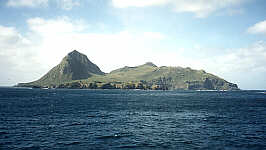 s unknown, unemployment is
virtually non-existent. In 1961 a dramatic volcanic eruption forced
the evacuation of the entire island, They were taken to what we glibly
refer to as 'civilisation'. Almost all chose to return to the island
when the the eruption was over. s unknown, unemployment is
virtually non-existent. In 1961 a dramatic volcanic eruption forced
the evacuation of the entire island, They were taken to what we glibly
refer to as 'civilisation'. Almost all chose to return to the island
when the the eruption was over.
This is called "the remotest island in the world". The Union
Jack flies over the houses, and the hearts of the islanders are as warm
and generous as they have always been.
MORE PICTURES - FOLLOW
THIS LINK
or back to Tristan da Cunha - index
on this website
|









